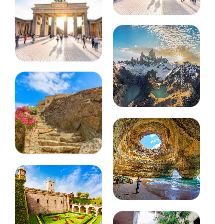Budapest baths: complete guide to the thermal baths
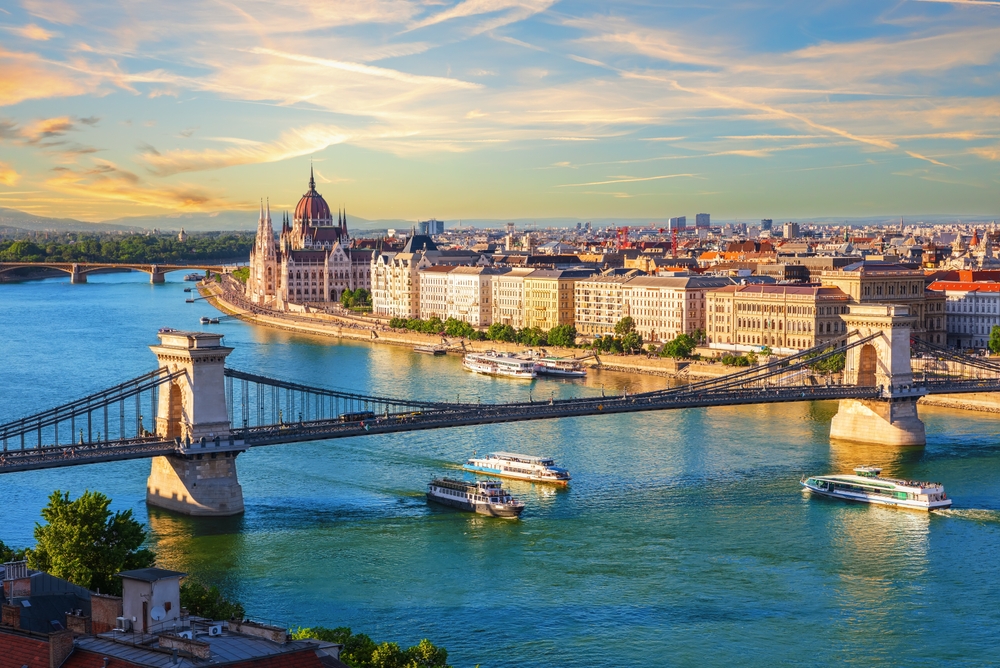
Budapest, nicknamed the “Pearl of the Danube”, is home to one of the largest collections of thermal baths in the world. With more than 130 hot springs feeding some fifteen thermal baths, the Hungarian capital invites you to discover a thousand-year-old tradition where relaxation and culture meet in sumptuous settings. This comprehensive guide to Budapest’s thermal baths will accompany you as you explore these architectural gems, from the majestic Széchenyi thermal baths to the authentic Rudas Turkish baths.
200 audioguided tours for cities all around the world
Download1. History of the Budapest thermal baths
The history of Budapest’s thermal baths dates back to ancient times. The Romans, who were the first to exploit these natural springs, established their regional capital Aquincum on the site of today’s Budapest, attracted by the exceptional properties of these hot waters gushing naturally from the ground. Even today, the remains of Roman thermal baths in the Óbuda district bear witness to this ancestral bathing tradition.
But it was really under the Ottoman occupation (1541-1686) that Budapest’s spa culture really took off. The Turks, who were great fans of hammams and public baths, built several establishments, some of which are still in operation today. These baths were used for hygiene, socialising and medical treatment. The architecture of this period, with its domes and octagonal pools, still marks the identity of Budapest’s baths today.
In 1934, Budapest was officially awarded the title of “City of Thermal Spas”, international recognition of its exceptional thermal heritage. Today, the city boasts more than 130 hot springs, supplying 70 million litres of water every day at temperatures ranging from 21°C to 78°C.
Also read the Budapest guide:
- Top 10 culinary specialities in Budapest
- Things to do in and around Budapest
- The best hotels to stay in Budapest
2. The great thermal baths of Budapest
2.1. The Széchenyi baths: the temple of thermalism
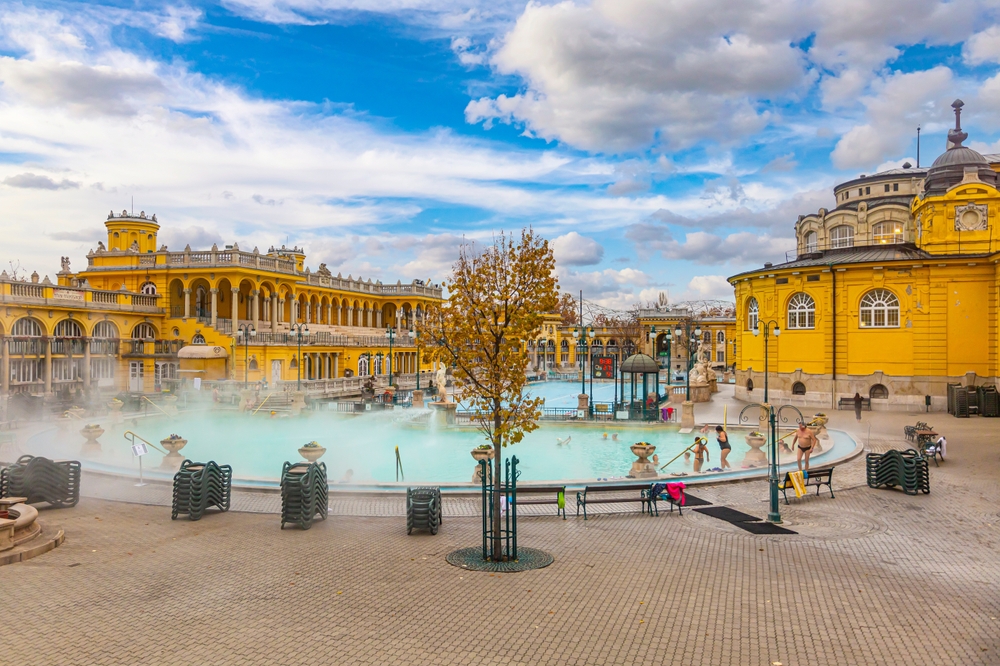
Inaugurated in 1913, the Széchenyi Baths are the largest spa complex in Europe and undoubtedly the most photogenic in Budapest. Located in the magnificent Városliget Park, these neo-baroque baths house 18 pools, including 3 spectacular outdoor pools.
The Széchenyi Baths (Állatkert krt. 9-11, 1146 Budapest, rated 4.4/5 on Google for over 45,000 reviews) offer thermal waters at various temperatures, Finnish saunas and massage services. The iconic image of chess players in the outdoor pools, even on snowy days, makes these baths a must for any stay in Budapest.
Practical information:
– Opening hours: 6am-10pm daily
– Prices: HUF 3,200 weekdays (approx. €25), HUF 3,600 weekends (approx. €29)
– Access: Metro M1, Széchenyi fürdő stop
– Services: Lockers, cabins, massages, restaurant
2.2. The Gellért baths: art nouveau and elegance
The Gellért baths, true gems of art nouveau, are among the most beautiful thermal baths in the world. Built between 1912 and 1918, they are nestled at the foot of the Gellért hill, in the hotel of the same name. Their sumptuous architecture, with its colourful mosaics, marble columns and glass roofs, makes them a veritable open-air museum.
The Gellért thermal baths (Kelenhegyi út 4, 1118 Budapest, rated 4.2/5 on Google out of 25,000 reviews) have 10 indoor and outdoor pools, a unique wave pool and a complete wellness area. The main pool, with its colourful glass ceiling, offers an absolutely magical swimming experience.
Practical information:
– Opening hours: 9am-7pm every day
– Prices: from HUF 6,900 (around €17)
– Access: Trams 19, 41, 56, Szent Gellért tér stop
– Special features: Wave pool in summer
2.3. The Rudas baths: the Ottoman heritage
Built in 1566 during the Turkish occupation, the Rudas baths offer the most authentic thermal experience in Budapest. Its octagonal main pool, topped by a dome with star-shaped openings, plunges you into the atmosphere of oriental hammams.
The Rudas thermal baths (Döbrentei tér 9, 1013 Budapest, rated 4.1/5 on Google out of 15,000 reviews) offer a unique experience with their panoramic rooftop pool, offering breathtaking views of the Danube and Parliament. The historic Turkish baths keep men and women separate on different days, adding to the authenticity of the experience.
Practical information:
– Opening times: 6am-8pm for thermal baths, panoramic pool until 10pm
– Prices: from HUF 3,500 (approx. €11)
– Access: Bus 7, 8E, tram 19, 41
– Special features: Rooftop pool overlooking the Danube
3. Confidential thermal baths
3.1. The Lukács baths: the local spirit
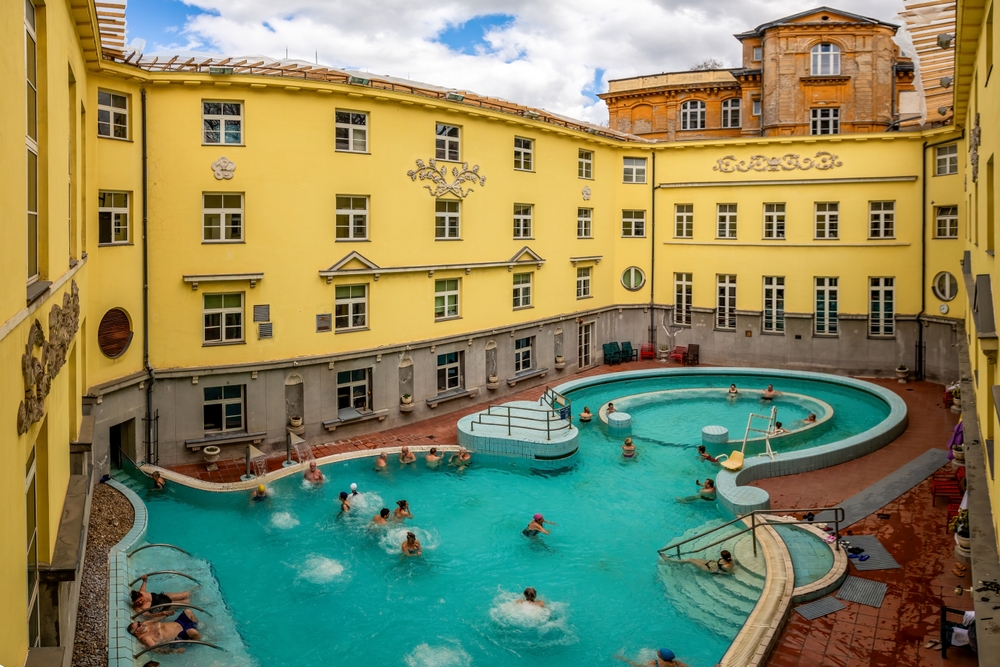
Frequented mainly by Budapest locals, the Lukács baths (Frankel Leó út 25-29, 1023 Budapest, rated 4.0/5 on Google out of 8,000 reviews) offer a more intimate and authentic experience. These century-old thermal baths are renowned for their waters with exceptional curative properties.
The walls are adorned with thank-you plaques left by cured patients, testifying to the medicinal reputation of these waters. The establishment has several thermal pools, a swimming pool and a modern sauna area.
Practical information:
– Opening hours: 6am-10pm weekdays, 6am-7pm weekends
– Fares: HUF 6,000 weekdays, HUF 7,000 weekends
– Access: Tramway 17, bus 86
– Atmosphere: Frequented by locals
3.2. The Veli Bej baths: the rebirth of a jewel
Recently renovated and reopened in 2012, the Veli Bej baths (Árpád fejedelem útja 7, 1023 Budapest) are one of Budapest’s best-kept secrets. These 16th-century Ottoman baths offer an intimate experience in a historically preserved setting.
With just six pools and limited capacity, Veli Bej guarantees a peaceful, relaxing atmosphere, far from the tourist crowds. The original Ottoman architecture, perfectly restored, creates a unique atmosphere.
3.3. The Palatinus baths: the island of relaxation
Located on Marguerite Island, the Palatinus baths (Soó Rezső sétány 1, 1007 Budapest, rated 4.2/5 on Google out of 12,000 reviews) combine thermalism and aquatic leisure. This unique complex offers 7 thermal and recreational pools, including several with slides.
Perfect for families, Palatinus offers an exceptional green setting in the heart of the Danube. Children can enjoy the water attractions while adults relax in the thermal pools.
4. Practical tips for visiting the Budapest baths
4.1. What should I bring?
To make the most of your spa experience, remember to bring :
– A swimming costume (compulsory)
– Towel (can be hired on site)
– Flip-flops or non-slip sandals
– Bathing cap (compulsory in some pools)
– Shower gel and shampoo
– A bottle of water to keep you hydrated
4.2. Etiquette and rules to be observed
Budapest’s thermal baths follow precise rules of etiquette that must be respected:
– Shower compulsory before and after each bath
– Swimming costumes must be worn in all communal areas
– Respect for silence and tranquillity
– No diving in the thermal pools
– Respect the non-mixed time slots in certain establishments
– Regular hydration recommended
Download the audio tour to discover Budapest on foot and on your own
Discover the secrets of Budapest with our interactive audio tour. This tour will take you through the most beautiful districts of the Hungarian capital, including the famous Gellért Baths and many other architectural gems. With 23 entertaining audioguides, you can explore Budapest on your own, from Buda to Pest, taking in iconic sites such as the Parliament, St Stephen’s Basilica and the thermal baths. The navaway® application accompanies you for an in-depth discovery of this pearl of the Danube.
4.3. When should you visit the thermal baths?
The timing of your visit has a major impact on your experience:
Morning (6am-10am): Authentic atmosphere with regulars, less crowds, sometimes preferential prices.
Noon (10am-3pm): Maximum tourist numbers, particularly at Széchenyi and Gellért.
Evening (3pm-close): Romantic atmosphere, subdued lighting, perfect for couples.
Weekend: Special entertainment at Széchenyi with the famous night-time Spa Parties.
5. The benefits of Budapest’s thermal waters
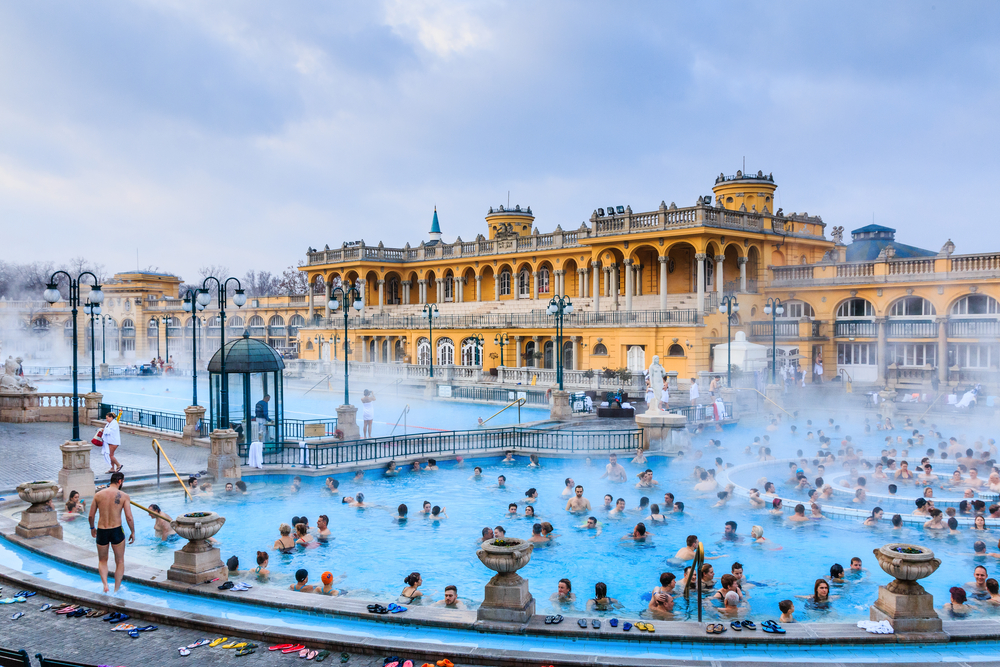
The thermal waters of Budapest are not only a source of relaxation, they also have recognised therapeutic properties. Rich in minerals such as calcium, magnesium, sulphate and bicarbonate, these waters are beneficial for :
– Rheumatic and joint disorders
– Blood circulation problems
– Skin disorders
– Stress and nervous tension
– Muscle recovery after exercise
Each spa has waters with slightly different compositions, some of which are better suited to specific needs. Don’t hesitate to ask the staff for advice on how to make the most of your wellness cure.
6. Prices and terms of access to the thermal baths
Prices at Budapest’s thermal baths vary according to the establishment and the period:
Széchenyi Baths: HUF 3,200-3,600 (€25-29)
Gellért Baths: HUF 6,900 (€17)
Rudas Baths: HUF 3,500 (€11)
Lukács Baths: HUF 6,000-7,000 (€15-18)
Palatinus Baths: HUF 3,800 (€9.50)
Most establishments offer discounts for students, senior citizens and families. Buying online often means avoiding queues and benefiting from preferential rates.
7. Combine thermal baths with exploring Budapest
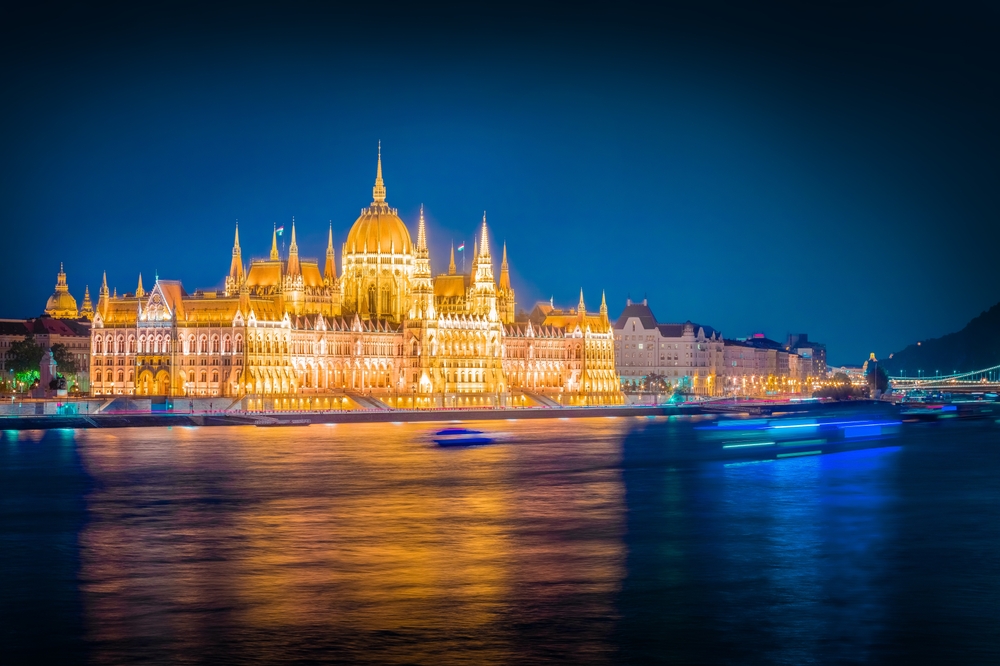
A visit to the thermal baths is the perfect way to discover Budapest. After a day’s walking in the historic centre, what could be better than a relaxing session in the hot springs? Take advantage of your stay to explore the different districts of the city with our Budapest sightseeing itinerary, which will take you from the heights of Buda to the banks of Pest.
The Gellért thermal baths, located at the foot of the hill of the same name, are an excellent starting point for exploring the Buda district. The Széchenyi Baths, in Városliget Park, are close to the zoo and Vajdahunyad Castle. Each spa is part of an environment rich in cultural discoveries.
8. Additional spa services
In addition to the thermal pools, the establishments in Budapest offer a full range of wellness services:
Therapeutic massages: massages with essential oils, sports massages, foot reflexology
Facial treatments: deep cleansing, thermal mud masks, anti-ageing treatments
Relaxation areas: Finnish saunas, steam rooms, relaxation rooms
Eating and drinking: Cafés and restaurants serving traditional Hungarian cuisine
These services will turn your visit into a day of total well-being.
In conclusion, Budapest’s thermal baths are one of the most authentic and relaxing experiences the Hungarian capital has to offer. Whether it’s the art nouveau elegance of the Gellért thermal baths, the friendly atmosphere of the Széchenyi baths or the historical authenticity of the Rudas baths, each thermal establishment tells a part of the history of this exceptional city. These temples to well-being, where tradition meets modernity, offer you an enchanted interlude in your discovery of Budapest. Don’t hesitate to consult our complete guide to visiting Budapest to make the most of your stay in this pearl of the Danube.
FAQ
How much does it cost to visit Budapest’s thermal baths?
Prices range from HUF 3,500 (€11) for the Rudas baths to HUF 7,000 (€18) for the Lukács baths at weekends. The Széchenyi baths cost around €25-29 depending on the season.
Do I need to book in advance for the Budapest baths?
Online booking is recommended, especially in high season and for the Gellért and Széchenyi thermal baths. You can avoid queues and sometimes benefit from preferential rates.
Can families with children visit the thermal baths?
Yes, but some establishments have age restrictions. The Palatinus baths are particularly suitable for families, with their slides and water play areas.
What is the difference between mixed and non-mixed baths?
Most baths are mixed today. Only the Rudas baths maintain separate male/female slots for the historic Turkish baths, depending on the day of the week.
How long does a visit to the thermal baths take?
Allow 2 to 4 hours to fully enjoy the experience. Half a day allows you to explore several pools, relax and, if you wish, enjoy a massage.
200 audioguided tours for cities all around the world
Download